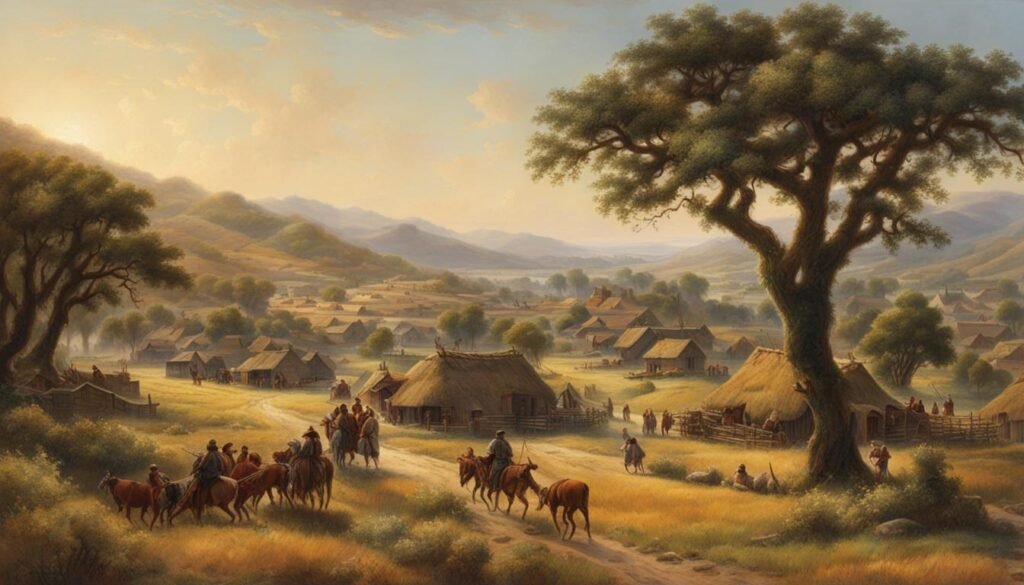Forests are the lifeline of our planet, providing numerous benefits that are vital for our survival. It is crucial that we prioritize forest preservation to protect our environment, conserve biodiversity, restore ecosystems, mitigate deforestation, and safeguard wildlife habitats. By implementing effective forest management strategies, supporting reforestation programs, and promoting green initiatives, we can ensure the long-term sustainability of our forests for future generations.
In this article, I will explore the importance of forest preservation, its role in climate change mitigation, how individuals can contribute to this cause, the need for global forest protection governance, the significance of forest stewardship, and the impact of forest preservation on pandemics.
Key Takeaways:
- Forest preservation is essential for conserving biodiversity, restoring ecosystems, and mitigating deforestation.
- Afforestation, reforestation programs, and effective forest management strategies are key to preserving our forests.
- Individuals can contribute by planting trees, supporting forest conservation groups, and choosing forest-friendly products.
- Global forest protection governance and technology play crucial roles in safeguarding our forests.
- Forest stewardship ensures the long-term health and preservation of forests for future generations.
The Importance of Forests in California
California is blessed with a rich diversity of forests that are of great importance to conservation efforts. Among these forests, the biggest one is the national forest in California, serving as a valuable resource hub, wildlife habitat, and recreational haven. The preservation and sustainable management of these forests are essential for safeguarding California’s natural beauty and ensuring the well-being of its residents.
Forest conservationists play a vital role in protecting and advocating for the sustainable use of these precious natural spaces. Their expertise and dedication help maintain the delicate balance between human activities and the preservation of these vital ecosystems.
Preserving Ecosystems and Wildlife
The forests in California are teeming with diverse wildlife species and provide crucial habitats for numerous flora and fauna. From towering redwood groves to majestic oak woodlands, these forests are home to various endangered and threatened species.
By implementing effective wildlife and forestry conservation efforts, we can protect and restore these ecosystems, allowing wildlife populations to thrive. The conservation of forests in California is not only important for the preservation of biodiversity but also for mitigating the effects of climate change.
Aiding Climate Change Mitigation
Forests in California play a significant role in serving as carbon sinks, effectively sequestering carbon dioxide from the atmosphere. This process helps mitigate climate change by reducing greenhouse gas emissions and stabilizing the Earth’s climate.
Through sustainable forestry practices and forest protection, we can prevent deforestation, promote reforestation, and restore degraded forest areas. These actions contribute to carbon sequestration, biodiversity conservation, and the overall effort to combat climate change.
Preserving Resources for Future Generations
The forests in California provide countless resources that support various industries, including timber, tourism, and recreation. By ensuring responsible forest management practices, we can maintain a sustainable supply of these resources for future generations.
Forest protection is not only about conserving natural habitats and preserving the environment but also about sustaining the economic well-being of local communities that rely on these forests for their livelihoods.
The Role of Forests in Climate Change Mitigation
Forests play a significant role in mitigating climate change by acting as carbon sinks and sequestering vast amounts of carbon dioxide from the atmosphere. The process of carbon sequestration, where carbon dioxide is absorbed by trees and stored in their biomass and soil, helps to reduce greenhouse gas emissions and combat global warming.
Beyond carbon sequestration, forests also contribute to biodiversity conservation by providing habitats for a wide range of plant and animal species. These diverse ecosystems support the balance of nature and foster the preservation of a variety of species, ensuring the health and resilience of our planet.
Sustainable forestry practices are essential for maintaining the long-term health and productivity of forests. By adopting responsible logging techniques, promoting reforestation efforts, and embracing sustainable land management practices, we can prevent deforestation and promote the preservation of our valuable forest resources for future generations.
In addition to preventing deforestation, forest ecosystem restoration holds great potential for mitigating climate change. Efforts to restore degraded forest areas can help revive biodiversity, enhance ecosystem services, and improve overall forest health. Through initiatives such as afforestation and reforestation programs, we can contribute to the restoration of damaged ecosystems and reverse the harmful effects of past deforestation.
By recognizing the vital role that forests play in climate change mitigation, we can take actions to protect and restore these precious ecosystems. Sustainable forestry, conservation, and restoration efforts are essential for preserving biodiversity, preventing deforestation, and ensuring the overall health of our planet. Let’s work together to safeguard our forests and secure a sustainable future.


Benefits of Forests in Climate Change Mitigation
- Carbon sequestration reduces greenhouse gas emissions and slows down global warming.
- Forests serve as habitats for a diverse range of plant and animal species, contributing to biodiversity conservation.
- Sustainable forestry practices help prevent deforestation and promote the preservation of forest resources.
- Forest ecosystem restoration restores biodiversity, enhances ecosystem services, and improves overall forest health.
How Individuals Can Contribute to Forest Preservation
As individuals, we have the power to make a significant impact on forest preservation. By taking simple yet meaningful actions, we can contribute to the protection and conservation of our precious forests. Here are some ways you can get involved:
Plant Trees
One of the most effective ways to support forest preservation is by planting trees. Trees play a crucial role in absorbing carbon dioxide, mitigating climate change, and providing habitats for countless species. Whether in your backyard or through community tree-planting initiatives, every tree planted makes a difference.
Support Forest Conservation Groups
There are numerous organizations dedicated to protecting and preserving forests. By supporting these groups through donations or volunteering, you directly contribute to their efforts in conserving forest ecosystems, implementing sustainable practices, and raising awareness about the importance of forest preservation.
Choose Forest-Friendly Products
When making purchasing decisions, opt for products that are sourced responsibly and have minimal impact on forests. Look for certifications such as Forest Stewardship Council (FSC) that ensure the products are derived from sustainably managed forests. By choosing forest-friendly products, you encourage sustainable practices in industries such as timber, paper, and furniture.
Adopt Responsible Outdoor Recreation Practices
If you enjoy spending time in nature, practicing responsible outdoor recreation is essential. Follow designated trails, avoid damaging vegetation, and refrain from littering or disturbing wildlife. By being mindful of our impact and respecting the natural environment, we can enjoy outdoor activities while preserving the integrity of forest ecosystems.
By incorporating these actions into our daily lives, we become guardians of our forests and contribute to the long-term preservation of these invaluable natural resources. Together, let’s ensure that future generations can enjoy the beauty and benefits that our forests provide.
The Urgent Need for Global Forest Protection Governance
Ensuring the preservation of our forests is essential, and it requires strong and effective global forest protection governance. The outlook for forest protection is becoming increasingly critical as we face numerous threats to our precious natural resources. To combat these challenges, it is imperative to implement inclusive and nature-based forest protection policies.
By adopting these policies, we can work towards equitable and carbon-neutral objectives. Preservation efforts can encompass initiatives such as afforestation, reforestation, and better forest management practices. However, the successful protection of our forests also relies on the integration of technology.
Technology plays a pivotal role in forest protection, enabling better monitoring and detection of threats such as illegal logging. Utilizing advanced tools and systems allows for real-time tracking and assessment of forest health. This invaluable data empowers policymakers, conservationists, and local communities to make informed decisions and take prompt action to protect our forests.


The integration of technology in forest protection paves the way for efficient and proactive measures. Satellite imagery, drones, and other cutting-edge technologies facilitate rapid response to forest fires, invasive species, and deforestation activities. Additionally, these advancements enable a more comprehensive understanding of forest ecosystems, identifying areas that require immediate attention and conservation efforts.
By implementing sound forest policies and utilizing technology effectively, we can safeguard our forests and ensure their protection for the future. Through collaborative global efforts, we can create a sustainable and thriving environment, preserve biodiversity, and mitigate the impact of climate change.
The Importance of Forest Stewardship
Forest stewardship plays a crucial role in ensuring the long-term health and preservation of our forests. As stewards of the earth’s natural resources, it is our responsibility to implement responsible management practices that balance the needs of both humans and wildlife. By prioritizing sustainable harvesting practices, monitoring resource extraction, and protecting biodiversity, we can create a harmonious relationship between forests and society, guaranteeing the continued benefits they provide for future generations.
Forest stewardship involves adopting practices that promote the conservation of earth’s natural resources. This includes minimizing the impact of resource extraction and implementing reforestation and restoration programs to replenish what has been harvested. By prioritizing sustainable practices, we can ensure that our forests continue to provide us with clean air, fresh water, and resilient ecosystems.
Furthermore, forest stewardship is essential for wildlife habitat protection. Forests serve as vital habitats for countless species, providing food, shelter, and breeding grounds. When we responsibly manage our forests, we create a safe haven for wildlife, allowing them to thrive and preserving the delicate balance of ecosystems. This, in turn, promotes biodiversity and contributes to the overall health of our planet.
The Benefits of Forest Stewardship
- Preservation of earth’s natural resources
- Protection of wildlife habitats
- Conservation of biodiversity
- Mitigation of climate change
- Sustainable provision of resources
Forest stewardship is not only about the present, but it also concerns future generations. By practicing responsible management and protection of our forests today, we can ensure that our children and grandchildren will inherit a world that still possesses the beauty and abundance of nature.
Join the movement for forest stewardship by supporting organizations and initiatives that promote sustainable practices. By making conscious choices in our daily lives, such as opting for sustainably sourced wood products and advocating for forest conservation policies, we can actively contribute to the preservation of our forests.
Let us embrace our role as stewards of the earth’s natural resources and take action to protect our forests. Through forest stewardship, we can safeguard wildlife habitats, preserve biodiversity, and ensure a sustainable future for our planet and future generations to come.
The Impact of Forest Preservation on Pandemics
Forest preservation plays a critical role in preventing pandemics. The close proximity between wildlife and humans in forests creates a risk of virus transmission from animals to humans. When these natural habitats are destroyed, it disrupts the delicate balance of ecosystems and increases the chances of viral outbreaks. By prioritizing forest conservation and protecting wildlife, we can mitigate the risks of future pandemics and safeguard public health.
Forests are rich in biodiversity, housing numerous species of animals, including potential carriers of viruses. When their natural habitats are disrupted, these animals may come into closer contact with humans, potentially increasing the likelihood of viruses spreading. The ongoing COVID-19 pandemic, which is believed to have originated from wildlife, serves as a stark reminder of the consequences of encroaching upon and destroying natural habitats.
Conserving forests helps maintain the natural barriers that prevent animal-borne viruses from jumping to human hosts. By preserving intact forests, we reduce the chances of human-wildlife interaction and the potential for new virus transmissions. Additionally, intact forests provide a buffer between urban centers and wildlife populations, further reducing the risk of exposure to zoonotic diseases.
Furthermore, forests play a crucial role in regulating climate and weather patterns, which indirectly impact the spread of infectious diseases. Healthy forests contribute to cleaner air and water, providing optimal conditions for human health and enhancing our immune systems. By protecting and conserving forests, we improve overall ecosystem resilience and bolster our ability to combat pandemics and other health crises.
Forest preservation goes hand in hand with pandemic prevention. Through proactive measures such as afforestation, reforestation, and sustainable forest management, we can create a healthier future for ourselves and future generations. Let us recognize the vital connection between forest conservation and public health, and act accordingly to safeguard our planet.
- Preserving intact forests helps to maintain a natural barrier between wildlife and humans, reducing the risk of virus transmission.
- Conserving forests improves ecosystem resilience and enhances our ability to combat pandemics and other health crises.
- Afforestation, reforestation, and sustainable forest management are key actions to create a healthier future for ourselves and future generations.
Conclusion
Forest preservation is crucial for our survival and the well-being of future generations. It is our responsibility to take action and ensure the long-term preservation of these invaluable ecosystems. Through green initiatives and sustainable practices, we can make a significant impact on protecting our forests.
By recognizing the importance of forest conservation, we can support relevant organizations and join their efforts in preserving and restoring these vital habitats. Every choice we make, from using forest-friendly products to adopting responsible outdoor recreation practices, contributes to the overall well-being of our forests.
Together, we can create a healthier planet and a brighter future for all. Let’s come together to safeguard our forests and ensure their protection for generations to come. The future of our planet and the well-being of future generations depend on our commitment to forest preservation and green initiatives.
FAQ
Why is forest preservation important?
Forest preservation is crucial for the well-being of our planet and future generations. Forests play a vital role in maintaining biodiversity, restoring ecosystems, mitigating deforestation, and protecting wildlife habitats.
What are the key strategies for forest preservation?
Key strategies for forest preservation include afforestation, reforestation programs, and effective forest management practices. These initiatives help ensure the long-term preservation of forests and the valuable resources they provide.
What is the largest forest in California?
The largest national forest in California is [Name of Forest]. It provides valuable resources, habitats for wildlife, and recreational opportunities.
How can individuals contribute to forest preservation?
Individuals can contribute to forest preservation by planting trees, supporting forest conservation groups through donations or volunteering, choosing forest-friendly products, and adopting responsible outdoor recreation practices.
What is the role of technology in forest protection?
Technology plays a pivotal role in forest protection by enabling better monitoring, detection of threats such as illegal logging, and assessment of forest health. It helps in safeguarding our forests and ensuring their protection for the future.
What is forest stewardship?
Forest stewardship involves responsible management practices that protect the earth’s natural resources while ensuring the habitat and well-being of wildlife. It includes promoting sustainable harvesting practices, monitoring resource extraction, and protecting biodiversity.
How does forest preservation relate to pandemics?
Forest preservation is crucial in preventing pandemics. Destruction of forest habitats disrupts natural ecosystems and increases the risk of virus transmission from animals to humans. By conserving forests and protecting wildlife, we can mitigate the chances of future pandemics and safeguard public health.









